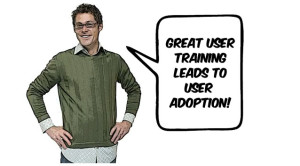You might be tempted to give Dynamics CRM user training a lower priority. After seeing how much CRM 2011 looks and feels like the Microsoft Office products we all know and love, it’s easy to assume that your users will be able to figure it out on their own. Yes, the software is intuitive. The Save button is the blue floppy disc icon that has been around for years; the buttons are all in the Ribbon, just as in Office 2010.
Consider this: when you choose to implement Dynamics CRM, why do you outsource some of the work? It’s not because the CRM system itself is extremely complicated. It’s because you have complicated business processes and need the CRM experts to help you translate those processes into a technical solution. When you’re thinking about training, remember that you are training your users on new processes, and a new way of doing their job. Although it’s helpful to provide a 10 minute navigation review, pointing out the Save button and the Ribbon, the heart of the training should focus on business processes.

Joe CRM’s Top 10 Rules for Dynamics CRM User Training:
- Cover the “Must-Do” First. Make a list of all of the things you can do in your CRM system. Out of that list, select the items that the users must be able to do in order to do their jobs. In the first round of training, only cover these items. Schedule follow-up trainings to cover advanced topics, such as Advanced Finds.
- Create a Quick Reference Guide. This guide will cover everything that a user must be able to do within CRM. Depending on your business processes, this could be 2-3 pages or 30-40 pages. Provide the guide in paper and electronic form. Include screen prints and diagrams, as appropriate. Add a section on Tips & Tricks, such as “type and tab” functionality on the lookup fields and underlined values in a View are hyperlinks.
- Have a Facilitator’s Guide. Creating a detailed Facilitator’s guide will allow you to pass the training onto another member of your team to train from. This guide should tell the facilitator where to click, what to say, and when to take breaks. The guide should also go along with a PowerPoint if the training is occurring in-person.
- Take Breaks. Don’t try and push through a full day of training with only a lunch break. Every 2 hours, take 10 minute breaks to allow users to make phone calls and check e-mail. This will also help to keep their minds fresh.
- Show, Then Do. If your training is 8 hours long, do not spend 4 hours straight teaching, then the next 4 hours with the users in CRM. Instead, spend 5-10 minutes teaching one function of CRM then have the users do it themselves for 10 minutes.
- Explain What Customer Relationship Management Is and Does. Some of your users may have experience using a CRM system. For others, this may be the first time. Spend time going over what a CRM system is and what it is going to do to help them do their jobs more effectively.
- Put up a Parking Lot. Don’t pave paradise, but you need a place to write down questions and requests. While you want to encourage users to ask questions, some may not be appropriate to answer at the time. Write them down and make sure you loop back around at the end of the training. You can cross of the questions that were answered during training, and get back to the questions that weren’t covered.
- Set Class Rules. Although you’re most likely teaching adults, you still need to set rules. No cell phones, laptop screens down or monitors off unless told to turn them on, minimal distractions.
- Teach to the Middle Curve. Every classroom has superstar students and less-than superstar students. The majority of the class will be somewhere in between. Set your agenda and level of detail to those students. After training, work with the users on the lower rung individually to catch them up.
- Keep Class Sizes Small. A lecture hall of 50 users will be difficult to control and questions will be left unasked. 10-15 is an ideal number. If you have a large organization, consider having multiple trainers. You could also train managers, provide them a facilitator’s guide, and require them to train their teams.
BONUS TIP: Know your team. If you have remote sales users who will not pay attention to an online training, make them travel for in-person training. If you have a user who will create disturbances, make them sit in the front of the room. If your team is driven by chocolate, keep a bag of chocolate at your podium and toss out to users who are asking or answering questions. If your team is driven by acknowledgement, print off “CRM Champion” certificates for them to hang by their desk. CRM is a big investment, and you do not want to skimp on training and risk poor user adoption.
We've got several other blogs on increasing CRM user adoption that you may also find useful:
Happy CRM'ing!
 How Microsoft Power Platform is helping to modernize and enable...
How Microsoft Power Platform is helping to modernize and enable... Deliver an Extraordinary Omnichannel Experience
Deliver an Extraordinary Omnichannel Experience Data Interoperability Key to Improving the Patient Experience
Data Interoperability Key to Improving the Patient Experience





